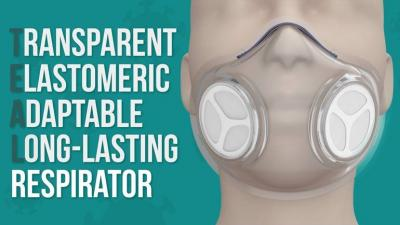Nov 11 2020
At the Brigham and Women’s Hospital and Massachusetts Institute of Technology, researchers have been exploring ways to develop a more improved, reusable respirator that could be used as a substitute for an N95 respirator.
 N95 Alternative TEAL respirator with sensors__with title Image Credit: Giancarlo Traverso.
N95 Alternative TEAL respirator with sensors__with title Image Credit: Giancarlo Traverso.
In the new iteration of their study, the researchers have introduced sensors that inform users whether the respirator is properly positioned and if the filters are becoming saturated.
The respirator is called the transparent, elastomeric, adaptable, long-lasting (TEAL). The researchers tested this device at Massachusetts General Hospital (MGH) and at the Brigham and Women’s Hospital, and reported a 100% success rate for fit testing among a total of 40 participants, with feedback showing excellent fit, breathability, and filter exchange. The results of the study have been published in the ACS Pharmacology & Translational Science journal.
During the COVID-19 pandemic, the need for respirators and masks has been urgent. Our team has worked to develop a respirator platform that not only fits comfortably and snugly but can also be sterilized and re-sterilized. In this study, we looked at up to 100 re-sterilization cycles and found that the TEAL respirator we’ve designed can withstand that.
Giovanni Traverso, MB, BChir, PhD, Gastroenterologist and Biomedical Engineer, Division of Gastroenterology, Brigham and Women’s Hospital
Traverso is also an assistant professor in the Department of Mechanical Engineering at MIT and the study’s corresponding author.
The researchers assessed seven different techniques to repeatedly sterilize the novel TEAL respirator. These techniques included 100 cycles of microwaving, 100 cycles of autoclaving, 100% isopropyl alcohol, extended exposure to UV treatment, bleach, and high heat (200 °C). But even after repeated sterilization, the team observed only a slight change in the respirator’s elasticity.
The latest TEAL respirator features a stretchy, transparent shell that can be sterilized, and also contains filters that can be substituted by users. The researchers observed that all participants could effectively substitute their filters and a majority of the participants (90%) reported a good or excellent fit for the TEAL respirator.
TEAL is the first elastomeric respirator designed for use in a surgical setting, preserving the sterile field and providing the user a comfortable, reusable personal protective equipment solution.
Adam Wentworth, MS, Study Co-Author and Senior Research Engineer, Division of Gastroenterology, Brigham and Women’s Hospital
Wentworth also works in Traverso’s laboratory.
The sensors integrated into the respirator can help detect exhalation temperature, respiratory rate, and inhalation and exhalation pressures. The researchers also applied a thermochromic coating to the TEAL respirator—a coating that changes from black to pink color when the TEAL respirator comes in direct contact with an individual’s face and thus has a snug fit.
To assess the performance of the respirator in a clinical setting, the researchers enrolled 47 subjects from MGH and the Brigham and Women’s Hospital. Among the participants, 40 individuals underwent fit testing.
The subjects were asked to score the respirator in terms of its fit, ease of filter exchange, and breathability, and they were also asked whether they favored the TEAL respirator to other alternatives. Among those queried, 60% favored the TEAL respirator when compared to 5% who favored the regular respirators supplied by hospitals. The remaining 35% of participants had no preference.
We were excited to receive the feedback from the trial participants that they would love to continue using and testing the respirator, given its comfort, transparency and ease of use.
James Byrne, MD, PhD, Study Co-Author and Resident, Department of Radiation Oncology, Brigham and Women’s Hospital
Byrne is also a postdoctoral fellow in Traverso’s laboratory.
Byrne observed that the transparency of the TEAL respirator, apart from its other aspects, may provide some benefits over more conventional respirators.
“One of the big benefits of the TEAL respirator is that it enables visualization of the lips,” added Byrne. “This can be immensely helpful in communication and expression, especially during this time when communication through N95 respirators and surgical masks makes it challenging to understand one another.”
Since the sample size of the work was small, the researchers recognized the significance of more evaluation in a larger cohort of people and across a longer timeframe to additionally test the functionality of the TEAL respirator.
To apply the TEAL respirator in hospital settings, more testing in accordance with the National Institute for Occupational Safety and Health (NIOSH) criteria will be required.
The trio—Wentworth, Byrne, and Traverso—and the study’s co-authors have currently filed numerous patents related to sensors and the respirator. Wentworth, Byrne, and Traverso also have a financial interest in TEAL Bio—a biotechnology firm focused on designing advanced personal protective equipment. One of the study’s co-author is on the board of directors for Analog Devices.
The study was funded by the Prostate Cancer Foundation (Prostate Cancer Foundation Young Investigator Award), the Department of Mechanical Engineering at MIT, Brigham and Women’s Hospital, the Karl van Tassel Career Development Professorship, the National Institutes of Health (NIHK23DA044874, R44DA051106, 456 5T32DK007191-45), investigator-initiated research grants from e-ink corporation, Gilead Sciences, Philips Biosensing, and the Hans and Mavis Lopater Psychosocial Foundation.
Journal Reference:
Wentworth, A. J., et al. (2020) Prospective Evaluation of the Transparent, Elastomeric, Adaptable, Long-Lasting (TEAL) Respirator. ACS Pharmacology & Translational Science. doi.org/10.1021/acsptsci.0c00157.